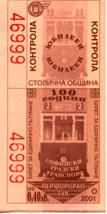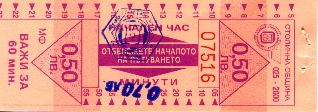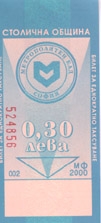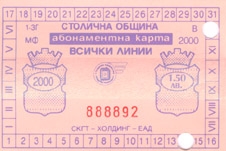Would you like to make this site your homepage? It's fast and easy...
Yes, Please make this my home page!
 Transport in Sofia
Transport in Sofia 
Taxies & public
Tickets | Itinerary taxies |
Taxies
As in every
other part of the world, in Sofia you can go from one place to
another on foot or by using a vehicle. If you prefer the second
way you can chose between several types of transport: bus,
trolley, tram, underground (subway) or taxi. Buses, trolleys and
trams are the most often used transport by the citizens because
they are the cheapest. The price for one ordinary ticket /good
for a single trip/ is 0,40 lv. If you use the public transport
you may witness some paradoxes. Most of the buses have been
overused. The rickety and ancient Hungarian Ikarus busses may
astonish you; at the same time you will occasionally see a new
Mercedes or Man. The same applies to the trams and trolleys. The
insufficient financial resources for Sofia's public transport are
the cause for its irregularity. The intervals of service are not
marked on the stops. The only sure thing is that public transport
runs daily from 5.00 a.m. till 11.30 p.m. As it was mentioned
beforehand, the price for one ticket for bus, tram or trolley is
0,40 lv. Tickets are the same for all the types of ground
transport. You have to perforate them inside the vehicle with the
perforating machines /they are installed in the vehicles/.
Besides the ordinary ticket there is another, which can be used
for two lines within the limits of one hour. The passenger marks
the beginning (hours and minutes) of his trip on the ticket. Its
price is 0.70 lv. If in one day you will transfer more than four
times it is better to buy a transit card for the day. The price
of this card is 2.00 lv. It gives you the right to use
limitlessly all the lines for this day. Tickets and cards are
sold at kiosks and newsagents. Some of the drivers sell tickets
too but it's better not to rely on this because there is no way
to know which one of the drivers has tickets for sale at the
moment. Very often salesmen don't know foreign languages so it's
best for you to say "billett" /ticket/ or
"karta" /card/. Tickets are inspected at random by
officials and control is very thorough. Passengers without a
ticket or a transit card pay a fine. Sofia's underground (subway)
is in sharp contrast with the other types of public transport
both because of its comfort and cleanness, as well as regularity.
As it was recently opened only a short section functions with one
line connecting the centre of the city with its western part
/housing estate Lyulin/. The underground (subway) functions daily
from 5.00 a.m. till midnight. The price for one ticket for a
single trip is 0.40 lv too but the ticket itself differs from the
ticket for the other types of public transport. There is a ticket
for two trips within the limits of one hour if the passenger
transfers the underground with ground transport or vice versa.
Its price is 0.70 lv. There are transit cards especially for the
underground. You can buy them at kiosks at the underground
entrances.
 |
Ordinary
ticket used for bus, trolley and tram for one
direction only without interruption. |
|
 |
| Special
ticket used for bus, trolley and tram for two
directions /that is, for changing the vehicle
once/ within the limits of sixty minutes. On the
one side of the ticket are marked the minutes, on
the other - the hour. |
|
 |
Ordinary
ticket used for the underground (subway) for one
direction only without interruption |
|
 |
| Special
ticket used for traveling with the underground
(subway) and the bus /trolley or tram/ for two
directions /that is, for changing the vehicle
once/ within the limits of sixty minutes/. On the
one side of the ticket are marked the minutes, on
the other - the hour. |
|
 |
Transit
card for one day for all lines.
The date is marked on it. |
|
Not so long
ago a special kind of taxi was launched in Sofia. Mini-buses
covering one or other fixed itinerary differing from the
itineraries of the ordinary public transport can be stopped at
your convenience. Their itineraries are composed much more
rationally than the ones of the public transport and this
explains why people prefer to use them. These "itinerary
taxis" can be discerned from a long distance, because on
their roofs there are big billboards with the description of the
itinerary and the itinerary's number. The number of the itineraries is about 40. The price of the trip with this
type of taxis is fixed - 1 lv. It does not depend on the
distance. Because of the specific financial stimulating of the
drivers they welcome gladly everyone who wants to get in even if
there is the smallest possibility to do so. These taxis are a
very convenient way of moving in Sofia faster.
 Taxicabs must be
yellow. They are literally everywhere. Taxi service here
is much cheaper than in many other places in the world.
The starting charge is 0.40-0.50 lv and the rates per km
vary from 0.40 to 0.60 lv. Every legal taxicab operates
by meter with a fiscal memory. Taxi drivers are obliged
to give every passenger a receipt with the covered
kilometers and the exact cost of the service. On a
prominent place in every cab there is a sign, which
displays the rates for the service during the day and
during the night. Taxi drivers often try to take
advantage of foreigners as an easy source of illicit
profits. That's why we advise you to follow some tested
rules: Avoid taking taxis at places where many tourists
usually gather, such as in front of the big hotels in the
centre of the city. The drivers of the cabs parked there
are usually specialized in "hunting" for
foreigners and the rates they offer are much higher than
the real ones. By law there are no special rates for
foreigners. Make sure in advance that the cost of the
service is the one written on the sign (for example 0.40
lv per km). If you think it's necessary ask the driver to
confirm it. After getting in the cab pay attention
whether the meter is turned on. If not, insist on it
without delay. Demand to be given the receipt at the end
of the trip. If you have doubts about the sum say so
before paying. When possible order the taxi by phone. Taxicabs must be
yellow. They are literally everywhere. Taxi service here
is much cheaper than in many other places in the world.
The starting charge is 0.40-0.50 lv and the rates per km
vary from 0.40 to 0.60 lv. Every legal taxicab operates
by meter with a fiscal memory. Taxi drivers are obliged
to give every passenger a receipt with the covered
kilometers and the exact cost of the service. On a
prominent place in every cab there is a sign, which
displays the rates for the service during the day and
during the night. Taxi drivers often try to take
advantage of foreigners as an easy source of illicit
profits. That's why we advise you to follow some tested
rules: Avoid taking taxis at places where many tourists
usually gather, such as in front of the big hotels in the
centre of the city. The drivers of the cabs parked there
are usually specialized in "hunting" for
foreigners and the rates they offer are much higher than
the real ones. By law there are no special rates for
foreigners. Make sure in advance that the cost of the
service is the one written on the sign (for example 0.40
lv per km). If you think it's necessary ask the driver to
confirm it. After getting in the cab pay attention
whether the meter is turned on. If not, insist on it
without delay. Demand to be given the receipt at the end
of the trip. If you have doubts about the sum say so
before paying. When possible order the taxi by phone. |

Taxi receipts. Here
are marked the covered distance /in kilometers/
and the price for 1 km
|
|
Thanks to Iliana Voynova
from www.bulgaria-travel.com
back to transport
![]() Transport in Sofia
Transport in Sofia ![]()

 Taxicabs must be
yellow. They are literally everywhere. Taxi service here
is much cheaper than in many other places in the world.
The starting charge is 0.40-0.50 lv and the rates per km
vary from 0.40 to 0.60 lv. Every legal taxicab operates
by meter with a fiscal memory. Taxi drivers are obliged
to give every passenger a receipt with the covered
kilometers and the exact cost of the service. On a
prominent place in every cab there is a sign, which
displays the rates for the service during the day and
during the night. Taxi drivers often try to take
advantage of foreigners as an easy source of illicit
profits. That's why we advise you to follow some tested
rules: Avoid taking taxis at places where many tourists
usually gather, such as in front of the big hotels in the
centre of the city. The drivers of the cabs parked there
are usually specialized in "hunting" for
foreigners and the rates they offer are much higher than
the real ones. By law there are no special rates for
foreigners. Make sure in advance that the cost of the
service is the one written on the sign (for example 0.40
lv per km). If you think it's necessary ask the driver to
confirm it. After getting in the cab pay attention
whether the meter is turned on. If not, insist on it
without delay. Demand to be given the receipt at the end
of the trip. If you have doubts about the sum say so
before paying. When possible order the taxi by phone.
Taxicabs must be
yellow. They are literally everywhere. Taxi service here
is much cheaper than in many other places in the world.
The starting charge is 0.40-0.50 lv and the rates per km
vary from 0.40 to 0.60 lv. Every legal taxicab operates
by meter with a fiscal memory. Taxi drivers are obliged
to give every passenger a receipt with the covered
kilometers and the exact cost of the service. On a
prominent place in every cab there is a sign, which
displays the rates for the service during the day and
during the night. Taxi drivers often try to take
advantage of foreigners as an easy source of illicit
profits. That's why we advise you to follow some tested
rules: Avoid taking taxis at places where many tourists
usually gather, such as in front of the big hotels in the
centre of the city. The drivers of the cabs parked there
are usually specialized in "hunting" for
foreigners and the rates they offer are much higher than
the real ones. By law there are no special rates for
foreigners. Make sure in advance that the cost of the
service is the one written on the sign (for example 0.40
lv per km). If you think it's necessary ask the driver to
confirm it. After getting in the cab pay attention
whether the meter is turned on. If not, insist on it
without delay. Demand to be given the receipt at the end
of the trip. If you have doubts about the sum say so
before paying. When possible order the taxi by phone.